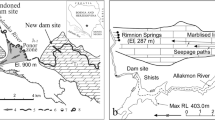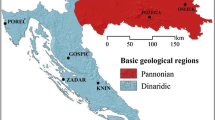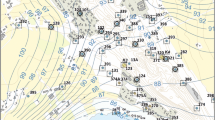Abstract
An artificial contribution to groundwater reserves in the areas of interest for water supply is a principal methodological target in modern hydrogeology. Investigations directed to this goal are of increasing significance all over the world to meet the growing demand for good water, which groundwater generally can be. Progress has been made in the sphere of practical development in permeable rocks of intergranular porosity, which cannot be said of discontinuous karst media, although it seems to offer greater opportunities. The ingrained notion and fear, even among specialists, of the inherent risk and uncertainty were invariably present wherever a resource was discovered in karst of a geosynclinal area; consequently progress has been limited. The reasons, however, for such a cautious approach are diminishing, because much knowledge has been gained about these aquiferous rocks, especially through investigations in the regions of surface storage reservoirs. Better knowledge of karst features and the results achieved in construction and consolidation of surface reservoirs have indicated that large amounts of groundwater can be recovered. The conventional water investigation and recovery methods have made available only small safe yields equal to the lowest natural discharge on the order of 100 I/sec). A reasonable use of a karst water resource and its better management cannot be considered without artificial control of the groundwater regime, i.e., without adjusting the regime to human demands. Groundwater flow balance in karst is becoming one of the principal problems, and future activities should be directed to the search for a bolder solution. A multidisciplinary team of geologists, geomorphologists, hydrogeologists, hydrologists, hydraulic engineers, etc., is required. In this paper a variety of solutions for water resource utilization in naked geosynclinal karst is suggested and far greater activity in this field is encouraged.
Similar content being viewed by others
References Cited
Komatina, M., 1973, Podzemne vode primorskog karsta Orebića u prirodnim i veštački izmenjenim uslovima. Vesnik Geozavoda, v. X/XI, ser. B, p. 37–51.
Komatina, M., 1975, Hidrogeološke odlike slivova centralnodinaridskog karsta. Rasprava Geozavoda, XVI, Beograd.
Komatina, M., 1984, Hidrogeološka istraživanja. Metode istraživanja, I. Geozavod, Beograd.
Milanović, P., 1979, Hidrogeologija karsta i metode istraživanja. Hidroelektrane na Trebišnjici, Trebinje.
Perić, J., 1963, Podzemne akumulacije kao hidrotehnički objekti u svrhu regulisanja režima proticaja karstnih i drugih izvora. Vesnik Geozavoda, v. III, ser. B, p. 67–97.
Author information
Authors and Affiliations
Rights and permissions
About this article
Cite this article
Komatina, M. Hydrogeological approach to investigation in karst for possible modification of groundwater regime and increase of recoverable reserves. Environ. Geol. Water Sci 16, 149–153 (1990). https://doi.org/10.1007/BF01890381
Issue Date:
DOI: https://doi.org/10.1007/BF01890381




